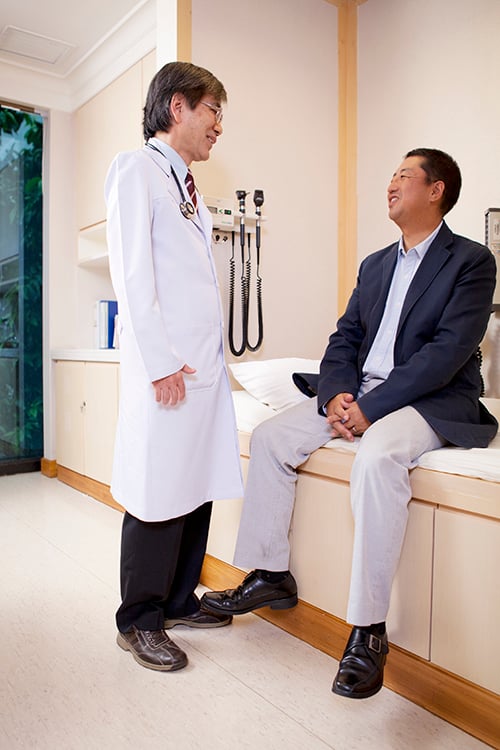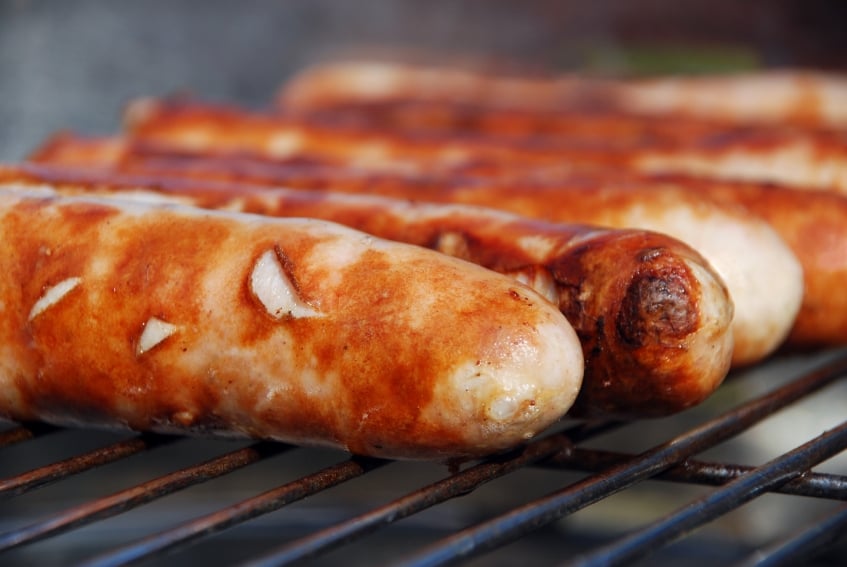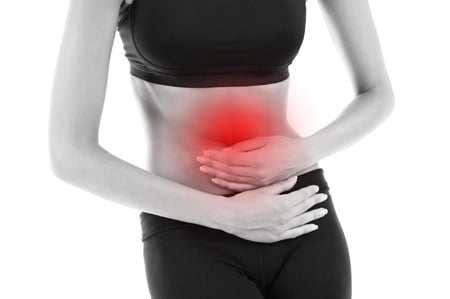When to worry about common abdominal pain?
To understand the abdominal pain symptoms is important because people will know how to heal themselves and when should consult the doctor. Abdominal pain is a common problem. Most abdominal pain can go away without special treatment such as pain from gastritis and pain from food poison. However, sometime the abdominal pain is hard to self-diagnose. Thus, please consult a doctor if the pain is acute and severe, the pain lasts more than 4 hours does not subside, the pain is accompanied by vomiting, or the pain does not go away after self-treatment.
The details of abdominal pain you may use for diagnosis

Where is the location or region area of pain such as pain in the upper abdomen, pain around navel, pain in the upper right side, pain in the upper left side, pain in the lower abdomen, pain in the lower right side, or pain in the lower left side? Is there a change in its quality or intensity or site of pain? How long is the patient suffering from pain such as a few hours, a few days, or a very long period of time?
What is the description of pain? Is the pain intermittent, constant, burning, stabbling, dull or crampy?
Does the pain tend to be sudden, sharp, stabling, and intense? Before seeing a doctor, does the pain develops gradually, worsens and not be able to tolerate?
Has the pain been tingling down to right or left shoulder, elbow, groin or testis?
Is the pain accompanied by loss of appetite, nausea, vomiting, constipation, diarrhea, fever, sweating, or fainting.
Is the pain triggered by eating certain foods, passing urine, defecating, snuffling, coughing, sneezing, or movement (sitting or sleeping)?
Is the pain subsided by vomiting, immobilization (sitting or sleeping), fetal position, foods, or medicine (antacids)?
Dose the patient has underlying such as diabetes, heart diseases, hypertension, allergy, gastric ulcer, kidney stone, abdominal surgery, or abdominal accident.
How does the patient personal activities such as menstruation cycle, sexual activity, alcohol drinking, smoking, exercising, routine works, or hobby that may relate to illness?
Dyspepsia/ Indigestion
It often occurs during or right after eating. Sufferers of dyspepsia often get attacks after eating too much or having gone too long between meals and allowing themselves to get excessively hungry.
The area of pain is above or around the navel.
The frequency of occurrence of which varies from one individual to another. In few cases individual may suffer with less discomfort after few hours and are able to eat as usual.
The symptom of some individual may not quite be significant; it is likely flatulence or bloating. If it occurs at irregular intervals, it may deem as a temporary problem caused by abnormal contractions of intestinal muscles. It is different from dyspepsia that the pain occurs every day and has continued for days, weeks or longer if the patient has not receive an appropriate treatment.
If you suspect a sign of peptic ulcers, please consult with your doctor for an appropriate investigation such as endoscopy, gastroscopy or gastrointestinal X-Ray with contrast.
Suggestions to reduce the suffering from dyspepsia include; if you experience the pain during having meal, you should stop eating, do not drink water and if possible try to walk briskly in fresh air. If you experience the pain after meal with drink, walking outdoor may also release pain. Over-the-counter medication includes fast-acting antacids such as Sodamint. You may initially take 4 tablets if your symptom does not improve within 5 minutes then take two more tablets. You may prevent this problem by avoiding all possible factors that may cause. In an unavoidable situation; if you are very hungry, take 2 tablets of Sodamint before the symptom happens. You may also use long-acting antacids such as Ranitidine. If the symptom has prolonged, please consult with your doctor for further investigation because the root cause of problem may cause from severe peptic ulcers disease, gallstones or heart diseases.
Helicobacter pyroli (H. pylori) enters the body through the mount or spreads back from colon to stomach. In general, our stomach does not have this germ. After spreading into stomach, H. pylori uses its flagella to burrow into the mucus lining of the stomach and releases enzyme and toxin, which leads to stomach ulcers. Its mechanism in associated with digestive enzyme overwhelms stomach and causes ulcers.
Food poisoning

Common symptoms of food poisoning include abdominal cramps, vomiting, and diarrhea. It can be caused by eating food contaminated with bacteria, viruses, chemicals or poisonous metals. You may feel pain around the belly button or upper. If abdominal pain is associated with vomiting, the pain will remarkably be relieved. Also, if abdominal pain is associated with diarrhea, the pain will remarkably be relieved. The common home remedy to help reduce symptoms of food poisoning includes placing a hot water bag on your abdomen (if vomiting continues). In case of no vomiting, you may take buscopan and ponstan. Although the pain is relieved, it is recommended to continue buscopan every 4 hours at least 3 times. If you are able to eat some food, you should take buscopan half a hour before meal. The abdominal cramp is usually improved within 24 hours.
In ideal conditions, most pathogen can multiply very quickly in summer. In some drought countries, the outbreak of communicable diseases usually occurs in summer, especially food and waterborne illness such as diarrhea, food poisoning, dysentery, cholera and typhoid. To prevent the problem, you should be aware of hygienic foods, drinks, food containers and toilets. Also, you should learn the common signs of diseases and how to prevent the problems.
Food poisoning can be caused by bacteria such as salmonella, campylobacter, fungus, poisonous mushroom, or foods that are contaminated by chemicals. It can also be caused by eating food that contaminated by bacteria which is made from half-cooked meats such as chicken meat, pork, meat, duck egg, chicken egg, canned food, seafood, unpasteurized milk. Moreover, the leftovers without refrigeration may cause to food poisoning if it is not well reheated before consuming.
Abdominal pain from appendix
The appendix is usually located in the lower right quadrant of the abdomen. When inflammation in the appendix begins, there is pain around the middle of the belly near the belly button. Within hours, the pain travels to your lower right-hand side and becomes constant and server. Coughing, sneezing, moving, or pressing on this area may make the pain worse. And also, you may have nausea, vomiting and fever.
These symptoms may occur within one day. You should seek medical attention for appropriate investigations. If appendicitis is suspected, doctors tend to err on the side of safety and quickly remove the appendix to avoid its rupture.
The appendix is designed to flight germs in colon, likes tonsil and adenoids that help to trap pathogens. The human appendix averages 10 cm in length. The diameter of the appendix is 1.5 cm. It normally sits in the lower right abdomen. Appendix, in anatomy, is a vestigial hollow tube that is closed at one end and attached at the other end to the cecum. As the appendix is usually located at the lower right side of the abdomen, if you start with a pain in the middle of your tummy, please aware of appendicitis and immediately consult your doctor.
Abdominal pain from gallstones and choleycystitis
Most people, approximately 80%, have gallstones with no symptoms. An inflammation can occur if the flow of bile in the cystic duct is severely impeded or blocked by any gallstones. This can cause severe abdominal pain in the center of your abdomen, just below your breastbone. The pain is sudden and rapidly intensifying, usually persistent and doesn’t go away within a few hours. The pain subsides as the gallbladder relaxes. The repeated episodes of gallstone attacks may occur after days, weeks or months. The pain is not intermittent and does not last for days.
If a bile duct becomes permanently blocked, it can cause the gallbladder to become infected. The pain does not subside and may spread to your upper right abdomen. The symptoms include pain when pressing on this area, fever, nausea and jaundice.
Women are more likely than men to develop gallstones. Stones are thought to be caused by an imbalance in the chemical make-up of bile inside the gallbladder. Gallstones can form if there are unusually high levels of cholesterol inside the gallbladder. Moreover, pigment stones occur when red blood cells are being destroyed and are more common in patients with some chronic hemolytic conditions.
Bile contains bile acids, which are essential for digestion and absorption of fats and fat-soluble vitamins in the small intestine. Many waste products are eliminated from the body by secretion into bile and elimination in feces. Secretion into bile is a major route for eliminating cholesterol. It is made soluble by bile acids and lipids like lecithin. Gallstones, most of which are composed predominantly of cholesterol, result from processes that allow cholesterol to precipitate from solution in bile.
Liver performed essential function related to bile production. Bile is important to digestion especially fat. Bile is produced by liver cells drains into microscopic canals known as bile canaliculi. The countless bile canaliculi join together into many larger bile ducts found throughout the liver. Some of the bile produced by the liver is carried to the duodenum of the small intestine while another some of bile is pushed back up the cystic duct by peristalsis to arrive in the gallbladder for storage. The gall bladder stores and concentrates bile during the fasting state. Typically, bile is concentrated five-fold in the gall bladder by absorption of water and small electrolytes - virtually all of the organic molecules are retained. The concentrated bile enables to digest better than bile produced directed from liver. Bile is a complex fluid mainly containing water, electrolytes, cholesterol, phospholipids, bile acids and bilirubin. Adult humans produce 400 to 800 ml of bile daily. The secretion of bile can be considered to occur in two stages. Initially, hepatocytes secrete bile into canaliculi, from which it flows into bile ducts. This hepatic bile contains large quantities of bile acids, cholesterol and other organic molecules. As bile flows through the bile ducts, it is modified by addition of a watery, bicarbonate-rich secretion from ductal epithelial cells.
Abdominal Pain from Gut Obstruction

Symptoms of gut obstruction can include cramping abdominal pain (generally coming in intense waves that strike at intervals of 5 to 15 minutes and sometimes center either on the navel or between the navel and rib cage), vomiting and flatulence. The difference of gut obstruction from food poisoning is no diarrhea.
The treatment requires an admission because the patient needs to fast and also may need operation.
The job of intestine is like a factory to transform what we eat and drink into small size and to absorb through the intestinal wall. For example, motility in intestine breaks fat from streaky pork to fatty acids and triglyceride, breaks protein from meat to amino acids and breaks carbohydrate from rice to glucose. These transformations need the entire intestinal system works together.
Small intestine is about 25 feet (7.5 meters) long. Large intestine is about 5 feet (1.5 meters) long. Although shorter than the small intestine in length, the large intestine is considerably broader about 3 times, measuring about 2.5 feet (7 centimeters). However, the intestine may be shorter than usual when digests food.
The lining of small intestine looks like carpet. The absorptive surface area of small intestine is about 30 yardages (250 square meters) – the size of two tennis courts and larger than its length. The large absorptive surface area is essential for digestion and absorption of food. It can be contained in small abdominal cavity by folding and coiling. The internal walls of the small intestine are covered in finger-like projection called villi and microvilli. These villi and microvilli increase the surface area available for the absorption of nutrients.
Large intestine looks like a pouch, about 150 centimeters long. It begins at the ileocecal junction and ends at the anus. It is subdivided into four main regions: cecum, colon, rectum and anal canal.
The cecum is an intraperitoneal pouch with a dead-end portion terminating with the appendix (1.5 – 2 inches long). There is a sphincter between the end of small intestine and the beginning of large intestine to prevent food from moving back up into the small intestine.
The colon is divided into four parts: The ascending colon continues upward to a bend in the colon called the hepatic flexure; the transverse colon follows the ascending colon and hepatic flexure. It lies across the upper part of the abdomen. It ends with a bend in the colon called the splenic flexure; the descending colon follows the transverse colon and aplenic flexure. It is on the left side of the abdomen; the sigmoid colon is the last part of the colon that follows the descending colon. It is an S-shaped loop.
Rectum is the lower part of the large intestine that connects to the sigmoid colon. It lies behind the bladder in males and uterus in females. It acts as a temporary storage site for feces.
The anal canal is the terminal part of the large intestine which wastes are excreted from the body. The ring at the terminal portion of the anal canal is called the anus. There is a sphincter muscle that relaxes to expel feces from the anal canal. After eating, it takes about 8.5 hours for food to pass through your small intestine to large intestine.
Unlike the small intestine, the large intestine produces no digestive enzymes. Its functions include the absorption of water and storage of feces. The feces are quite sticky and usually hard when you are very constipated. The hard feces may cause to having to strain to pass stool and hemorrhoids. The large intestine houses various bacteria that are useful. They destroy harmful bacteria and break down big food molecules. The harmless bacteria break down some food and produce gas expelled through the anus.
